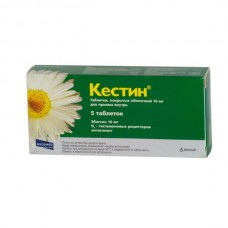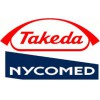Expiration date: 02/2025
Structure and Composition:
Tablets, film-coated. 1 tablet contains 10 mg of micronized ebastine
Excipients: MCC - corn starch 20 mg - Lactose monohydrate 5.2 mg - 88.5 mg Sodium carboxymethylcellulose structured - 5 mg Magnesium stearate - 1.3 mg
shell: hydroxypropyl - 1,725 ??mg of polyethylene glycol 6000 - 0.575 mg of titanium dioxide - 0.575 mg
card of 5 or 10 pieces. In the paper cartons 1 blister.
Characteristic:
Tablets, film-coated: round shape, white color. On one side of the tablet there is a risk and engraving «E 10".
Syrup: clear, colorless or slightly yellow solution with a smell of anise.
Pharmachologic effect:
Blocks H1-receptors, and prevents them from binding to histamine.
Pharmacokinetics:
Rapidly absorbed and almost completely metabolized in the liver to the active metabolite - karebastina. After a single dose of tablets at a dose of 10 mg Cmax karebastina (80-100 ng / ml) was achieved after 2,6-4 hours after a single dose of the syrup at a dose of 5 mg or 10 mg Cmax karebastina (108-209 ng / ml) was achieved in 2, 8-3,4 hours. High fat diet accelerates absorption (concentration in the blood increased by 50%). It does not cross the blood-brain barrier. Simultaneous administration of tablets with food helps to increase the blood level karebastina in 1,6-2 times, but does not change the time to reach Cmax and clinical effects. With daily pill 10 mg equilibrium concentration (130-160 ng / ml) was recorded after 3-5 days.
When pill binding to plasma proteins and Kestine karebastina is more than 95%, T1 / 2 karebastina - 15-19 hours.
Return with urine in the form of conjugated metabolites 60-66%. In patients with renal insufficiency T1 / 2 karebastina increases to 23-26 hours, with liver failure - up to 27 hours, but the concentration of the drug while taking 10 mg / day does not exceed the therapeutic values.
Pharmacokinetic parameter values ??are independent of age.
Description of the pharmacological actions:
After ingestion pronounced antiallergic action starts after 1 hour and lasts for 48 hours. After 5 days of treatment antihistaminic activity is maintained for 72 hours due to the action of the active metabolites. The drug has no pronounced anticholinergic and sedative effect.
Testimony:
Allergic rhinitis, seasonal and / or year-round (caused by household, pollen, epidermal, food, drugs and other allergens), urticaria (caused by household, pollen, epidermal, edible, medicinal allergens, insect bites, exposure to sun, cold, etc..) Allergic diseases and conditions caused by an increased release of histamine.
Contraindications:
- Hypersensitivity to the drug, pregnancy, lactation, children under 6 years.
- Be wary - if renal or hepatic insufficiency.
Application of pregnancy and breastfeeding:
Not recommended (safety of use in pregnant women and the allocation of the breast milk of nursing women have not been studied).
Side effect:
Headache, dry mouth, rarely - dyspepsia, nausea, insomnia, drowsiness, abdominal pain, asthenia syndrome, sinusitis.
Drug Interactions:
Do not appoint Kestine simultaneously with ketoconazole and erythromycin.
Kestine does not interact with theophylline, indirect anticoagulants, cimetidine, diazepam, ethanol and ethanol-preparations.
Dosage and administration:
Inside. Children 6-11 years - 5 mg (. 5 ml syrup or Table 1/2) 1 times a day, 12-15 years of age - 10 mg (10 ml of a syrup or Table 1). 1 time per day. Adults and children over 15 years: 10-20 mg (. 10-20 ml syrup or table 1-2) 1 time per day.
If abnormal liver function the daily dose should not exceed 10 mg.
The daily dose of 20 mg is appointed on the recommendation of a doctor.
Kestine taken regardless of meals.
Overdose:
Treatment: gastric lavage, monitoring of vital functions, symptomatic therapy.
No specific antidote exists.
Precautionary measures:
Be wary appoint patients with an increased QT-interval and hypokalemia.
Special instructions:
No effect on ability to drive and use machines.




